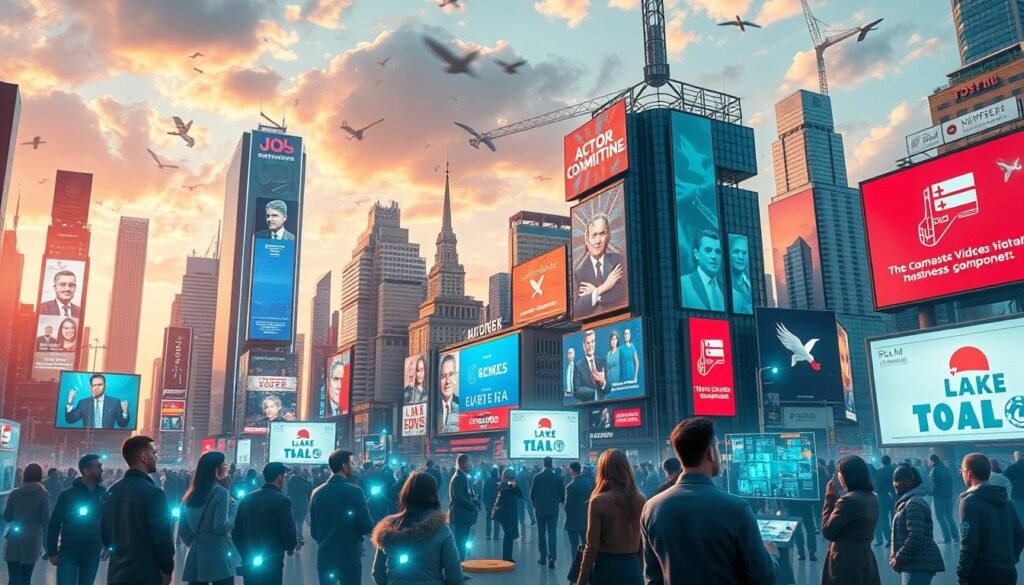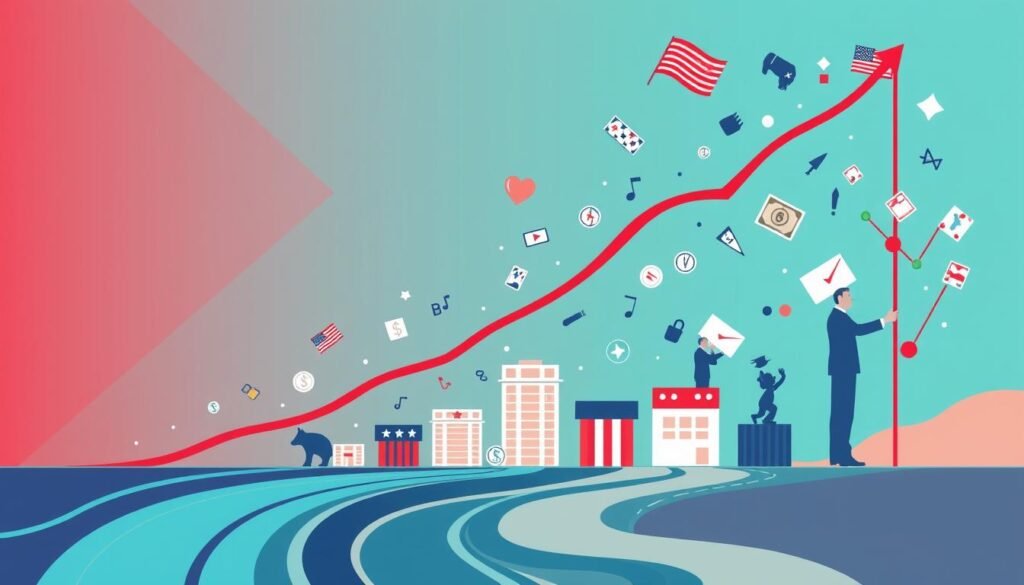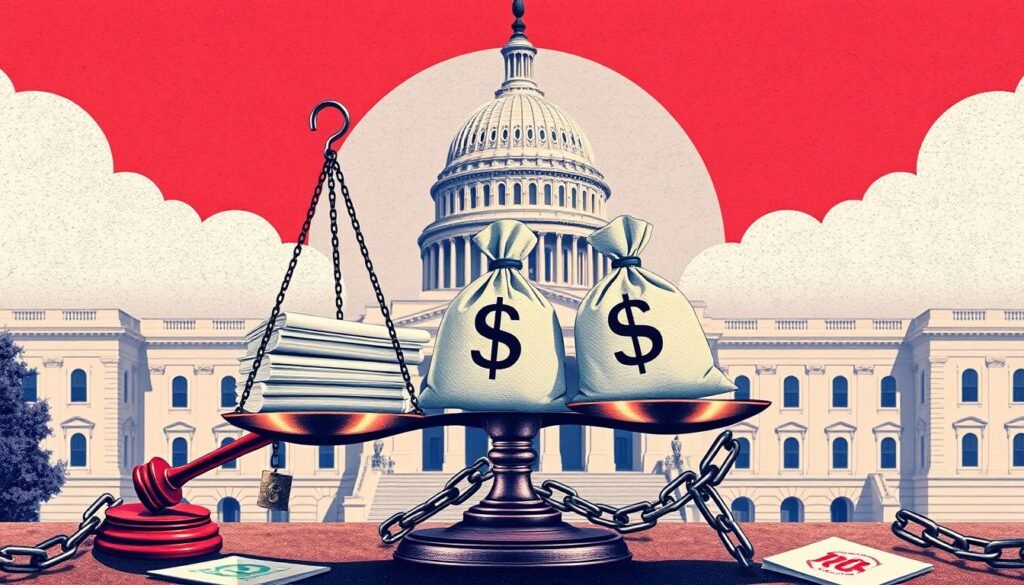The Future of PACs in American Politics
Elon Musk donated $250 million to super PACs backing President Donald Trump’s 2024 campaign. This shows how much money can influence politics. The role of Political Action Committees (PACs) is changing, thanks to the Citizens United decision. Super PACs and dark money groups are becoming more common, making it key to know about campaign finance.
Key Takeaways
- The Citizens United decision lets corporations and individuals spend unlimited money on elections. This has led to more PAC activity.
- Super PACs have been legal for 10 years, showing their recent rise in American politics. They have a big impact on PAC trends.
- The role of PACs in American politics is vital. The growing influence of money affects our democracy.
- Acts like the Stop Illegal Campaign Coordination Act and the DISCLOSE Act aim to make campaign finance clearer. They try to address concerns about PAC trends.
- Super PACs might become more common in congressional primaries. This could happen as political parties’ divisions lessen, shaping the future of PACs.
Understanding Political Action Committees: A Modern Perspective
Political Action Committees (PACs) are key in American politics. They shape elections and policy through political fundraising strategies. The impact of PACs on elections sparks debate, with some seeing them as corrupting.
PACs come in types like separate segregated funds (SSFs), nonconnected committees, and super PACs. Laws and regulations have shaped PACs’ history.
Definition and Types of PACs
To grasp PACs’ role, knowing their definition and types is vital. PACs collect money from groups to back candidates or causes.
Historical Evolution of PACs
PACs have changed politics, making parties less central. The number of PACs linked to leaders has soared.
Role in Democratic Process
PACs have brought more interests to Congress, affecting politician coalitions. They might make the legislative process less open, possibly reducing citizen legislators.
| Type of PAC | Characteristics |
|---|---|
| Separate Segregated Funds (SSFs) | Founded by corporations, unions, or trade groups |
| Nonconnected Committees | Not backed by a corporation, union, or trade group |
| Super PACs | Can raise and spend unlimited funds for candidates |
In summary, knowing about PACs is key to understanding their role in American politics. By understanding their definition, types, and history, we can see their impact on elections and political fundraising strategies.
The Current State of Political Action Committees in American Politics
Political Action Committees (PACs) in American politics are spending more than ever. Campaign finance regulations help keep an eye on money’s role in politics. Recent numbers show PACs are pouring millions into campaigns.
A PAC spending analysis shows a big jump in donations over 30 years. In 1990, PACs raised $333 million. By 2022, that number jumped to $482 million. This growth has sparked worries about transparency and accountability in campaign finance regulations.
- PAC contributions made up 23% of House candidates’ funds and 10% of Senate candidates’ funds.
- Leadership PACs gave over $67 million to federal candidates in 2018 and nearly $69 million in 2024.
The role of money in politics is getting bigger. This makes campaign finance regulations more important than ever. A detailed PAC spending analysis is key to grasping PACs’ role in American politics and their effect on democracy.
Digital Transformation of PAC Operations
The digital world has changed how Political advocacy groups talk to voters and collect money. This change lets groups reach more people and get support for their causes.
Important parts of this change are social media, online fundraising, and using data to make decisions. These tools help Lobbying efforts in politics be more focused and powerful, making a bigger difference in politics.
Some good things about digital change for PACs are:
- They can talk to more voters and get them involved.
- They can raise more money online.
- They can make better choices with data.
As digital technology keeps getting better, Political advocacy groups will use digital tools more. This way, PACs can do more to influence politics.
Super PACs: Reshaping Campaign Finance
The rise of super PACs has changed PAC trends a lot. Now, people and groups can spend as much as they want on elections. This has led to more money coming from rich donors and super PACs.
The Impact of PACs on elections is a big topic. Many say the current system makes it hard to see who’s funding campaigns. The 2024 federal election is expected to cost almost $16 billion. Super PACs are a big part of this spending.
Some important facts about super PACs include:
- Super PACs spent about $65 million on independent spending in the 2010 election cycle.
- Nearly two-thirds of the $95 million for presidential and congressional politics came from rich individuals.
- Federal law lets you give $5,000 a year to regular PACs. But Super PACs can take unlimited donations.
Super PACs are now a big deal in campaign finance. Many candidates count on these groups for funding. But, the lack of transparency and the risk of dark money affecting elections are big worries.
The Impact of Citizens United on PAC Evolution
The Citizens United decision changed PACs a lot. Now, corporations and individuals can spend as much as they want on elections. This has made PACs more active, with many groups spending millions on campaigns.
Changes in Spending Limits
Before Citizens United, rules stopped corporations and unions from using their money for election ads. The ruling changed this, making campaign finance regulations more flexible. But, it also raised worries about money’s influence in politics. This shows why we need good PAC spending analysis for transparency.
Corporate Involvement and Transparency Challenges
Almost 60% of super PAC spending comes from just 200 people and their families. This shows why campaign finance regulations and PAC spending analysis are key. They help keep democracy fair and honest.
Donor numbers have started to drop for the first time in decades after Citizens United. Spending by small donors has also gone down. This makes people think democracy mainly helps the rich, with huge wealth gaps.
| Year | Super PAC Spending | Number of Donors |
|---|---|---|
| 2010 | $60 million | 100,000 |
| 2014 | $600 million | 50,000 |
| 2018 | $1.5 billion | 30,000 |
The role of money in politics is getting bigger. So, we need strong campaign finance regulations and detailed PAC spending analysis more than ever. Keeping political contributions transparent and fair is key to a healthy democracy.
Emerging Trends in PAC Fundraising Strategies
PACs are changing their political fundraising strategies to keep up. They now use digital platforms to reach more people. This includes social media and online fundraising sites, helping them raise more money and get more supporters.
Some key PAC influence on policy decisions strategies are:
- Using email marketing to boost PAC contributions
- Setting up auto-deductions through payroll for regular donations
- Having a dedicated PAC website for donations and updates
- Hosting events like online auctions or guest talks to get more donations
| PAC Type | Fundraising Strategy |
|---|---|
| Corporate PACs | Utilizing email marketing and auto-deduction |
| Nonconnected PACs | Raising funds from the general public |
| Super PACs | Accepting unlimited donations from individuals and corporations |
PAC Influence on Policy Making and Legislative Processes
PACs play a big role in shaping policy and legislative actions. They help set agendas and rally public support. Many groups spend millions on lobbying efforts. Recent data shows PACs gave 5% of funds in the 2020 election, down from 9% in 2016.
The influence of PACs goes beyond direct lobbying. They also shape public opinion and build grassroots support. Lobbying efforts in politics can greatly sway policy decisions. Here are some key facts about PAC contributions:
- PACs can give $5,000 to a candidate committee per election.
- PACs can give $15,000 a year to national party committees.
- PACs can give $5,000 a year to other PACs and make unlimited donations to Super PACs.
The PAC influence on policy decisions is complex. It affects legislative processes in both direct and indirect ways. As PACs’ roles change, understanding their impact on policy and democracy is key.
Regulatory Challenges and Reform Proposals
The need for strong Campaign finance regulations is urgent. Money’s growing role in politics demands action. Reform ideas include more disclosure, limits on PAC spending analysis, and better enforcement.
Some numbers show why these changes are vital: in the first quarter of 2024, over 1.2 million people donated to House and Senate races. Most of these donations were under $20. The Small Dollar Donor Protection Act (SDDPA) seeks to accurately report grassroots support.
Here are some key points about the SDDPA:
- Requires campaigns to report the number of contributions received that were less than $200
- Mandates a study to investigate outreach efforts for small dollar donations and identify any deceptive tactics employed by campaigns
- Aims to enhance public access to disclosure, with the Federal Election Commission (FEC) instructed to issue guidance within 90 days of the enactment of the SDDPA
These reforms are key to keeping elections fair and preventing money’s corrupting influence. By enforcing Campaign finance regulations and PAC spending analysis, we can make campaign finance more transparent and accountable.
The Role of Technology in PAC Evolution
Technology has changed how Political Action Committees (PACs) work. It lets political advocacy groups collect more money and get more people involved. Now, lobbying efforts in politics use digital tools to reach more people.
Here are some ways technology is changing PACs:
- Blockchain technology to increase transparency in campaign finance
- Artificial intelligence (AI) in campaign strategy to target efforts more effectively
- Digital payment innovations to make it easier for PACs to raise money and mobilize supporters
Studies show local campaigns use generative AI more. But, campaigns with big Super PACs funds use it too. There’s worry about AI being used to spread false information.
Technology in PACs brings up big questions about openness and rules. As lobbying efforts in politics grow, it’s key that political advocacy groups use tech in a clear and honest way.
| Technology | Impact on PACs |
|---|---|
| Blockchain | Increased transparency in campaign finance |
| AI | More effective targeting of campaign efforts |
| Digital payments | Easier fundraising and mobilization of supporters |
Public Perception and Trust in PAC Operations
The public’s view of PACs is shaped by worries about money’s role in politics. Transparency in campaign finance is a big issue. Many wonder how PACs affect elections. PAC trends show a big rise in PAC numbers, with over 3,500 by 1983.
Recent stats show 72% of U.S. adults want limits on campaign spending. This shows the need for more transparency and accountability. The role of PACs in elections is a hot topic. Many see PACs as key in rallying public support and setting agendas.
- Over 60% of all national PACs are corporate PACs.
- The top ten business PACs donated $2,435,207 to federal candidates in 1982.
- 85% of Americans think campaign costs keep good people from running.
These numbers show PACs’ big impact on politics and the need for more openness. The debate on PACs and their role in elections is ongoing. It’s key to think about PACs’ role in democracy and the need for change to hear all voices.
International Comparisons: PACs in Global Context
Looking at Political Action Committees (PACs) in the U.S. means seeing them in a global light. We must compare how Political advocacy groups and Lobbying efforts in politics work around the world. Campaign finance and lobbying rules differ greatly, with Europe focusing on openness and Asia on state control.
It’s important to see how these systems affect democracy. The power of money and special groups can change politics in unique ways. Learning from other countries helps us understand PACs better and where they might go next.
- Diverse regulatory frameworks governing campaign finance and lobbying
- Varying levels of transparency and accountability in political advocacy
- Different approaches to addressing the influence of money in politics
By studying these global views, we get a clearer picture of PACs, governments, and societies worldwide. This helps us understand the complex relationships between them.
Conclusion: The Path Forward for PACs in American Democracy
As the 2024 election cycle approaches, the role of political action committees (PACs) in shaping the American political landscape is under intense scrutiny. The influence of money in politics is growing, making effective campaign finance regulations more urgent than ever.
PACs are key in mobilizing public support for causes and shaping the political agenda. Yet, there’s a growing concern about the influence of wealthy donors and special interests. Recent polls show that Americans’ trust in government and elected officials is at an all-time low. Many believe politicians listen more to big donors than to regular citizens.
The future of PACs in American democracy hinges on finding a balance between transparency and accountability. The Supreme Court’s rulings have shaped the legal landscape. It’s vital to study the effects of money in politics and explore new campaign finance models that give a voice to all citizens.
The path forward for PACs in American politics depends on public engagement and holding elected officials accountable. By addressing the causes of public disenchantment and restoring faith in the political system, the United States can move towards a more inclusive and responsive democracy.
FAQ
What is the definition and types of PACs?
How have PACs evolved historically?
What is the current state of PACs in American politics?
How have digital platforms and data analytics transformed PAC operations?
What is the role of super PACs in campaign finance?
How has the Citizens United decision impacted the evolution of PACs?
What are the emerging trends in PAC fundraising strategies?
How do PACs influence policy making and legislative processes?
What are the regulatory challenges and reform proposals related to PACs?
How has technology impacted the evolution of PACs?
How is the public perception and trust in PAC operations shaped?
How do international comparisons of PACs in a global context reveal different approaches to campaign finance and lobbying?
Source Links
- How Does the Citizens United Decision Still Affect Us in 2025?
- Super PACs: The Nominating Committees of the Future
- Oral Histories of the American South
- Political Priorities, Voting, and Political Action Committee Engagement of Emergency Medicine Trainees: A National Survey
- Microsoft Word – 071808 e-news.doc
- Political action committee
- American Medical Association Political Action Committee: How does the AMA affect health care policy?
- Super PACs and their effect on U.S. presidential politics | Harvard Magazine
- Are You Considering Starting a Federal Connected PAC?
- Future Forward USA PAC (FF PAC) – FactCheck.org
- The influence of super PACs and dark money on this year’s campaigns
- The United States’ campaign finance race is spiraling out of control
- Citizens United v. FEC – FEC.gov
- PAC fundraising: raising money to influence elections – NGP VAN
- 7 Effective PAC Fundraising Ideas to Increase Contributions
- The Influence of Campaign Contributions on the Legislative Process
- Facts about PACs: The role of political programs and the importance of engagement
- Political Money: Deregulating American Politics, Selected Writings on Campaign Finance Reform Edited by Annelise Anderson
- Reps. Jayapal, Balint, Tonko Introduce Campaign Finance Reform Legislation – Congresswoman Pramila Jayapal
- ILR-103-Yablon
- Campaign Finance Regulation
- Political Machines: Understanding the Role of AI in the U.S. 2024 Elections and Beyond – Center for Media Engagement
- THE EVOLVING CONGRESS
- Political Action COmmittees: Their Impact on Elections and Government
- 7 facts about Americans’ views of money in politics
- Comparing Democratic Distress in the United States and Europe
- IMPACT OF POLITICAL ACTION COMMITTEE ON GOVERNMENT CONTRACTS
- The Business PAC Phenomenon: An Irony of Electoral Reform
- Money in Politics: Campaign Finance and Its Influence Over the Political Process and Public Policy, 52 UIC J. Marshall L. Rev. 185 (2018)
- empirical evidence_4.20.2017.pdf
























